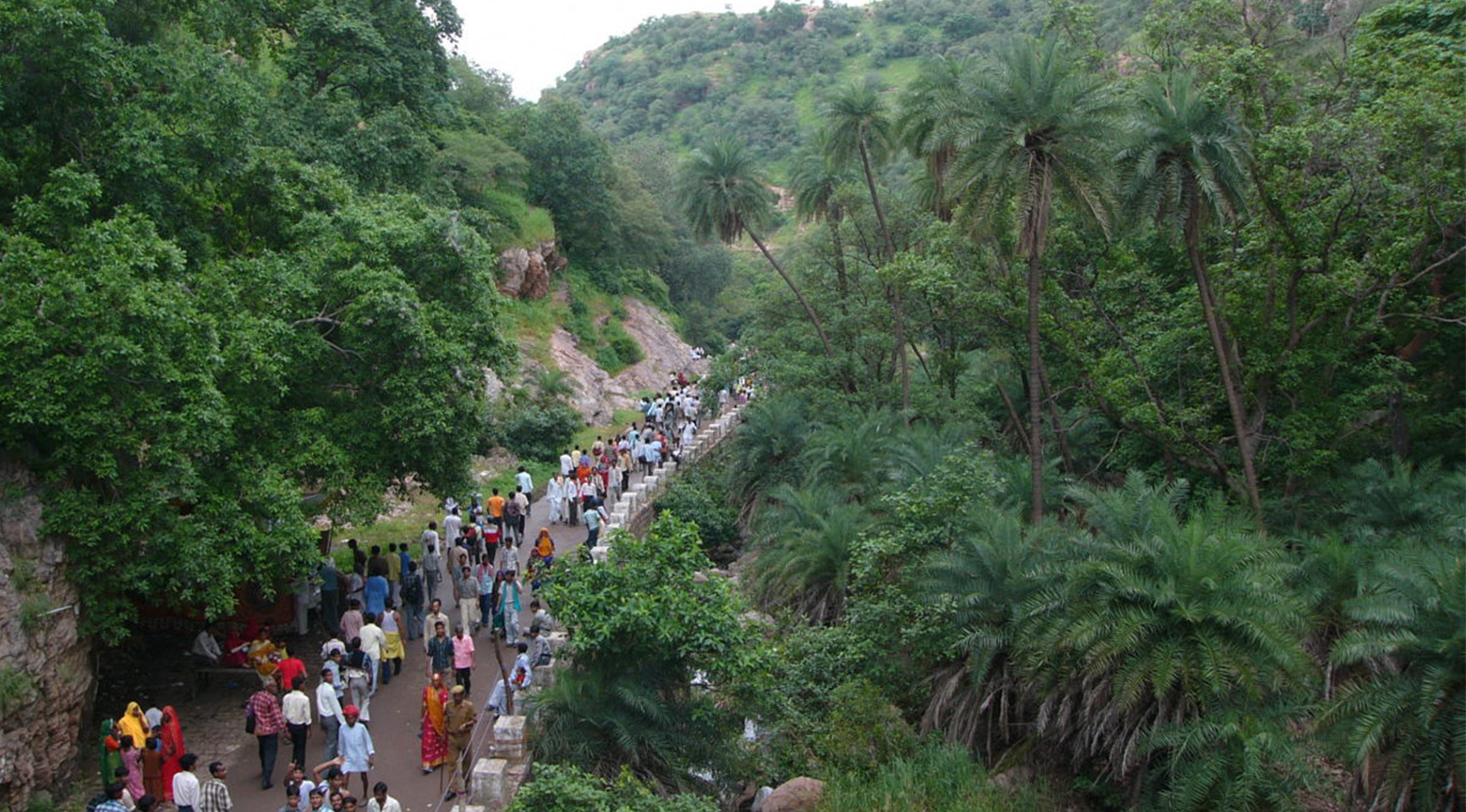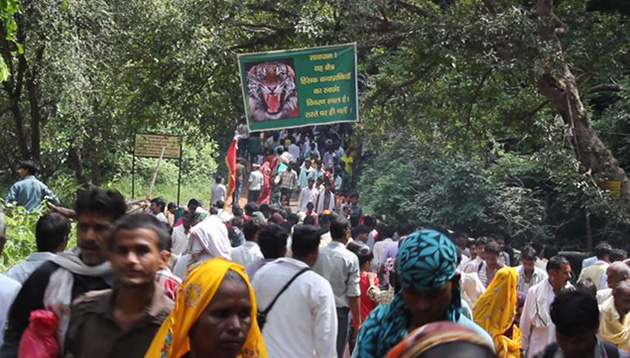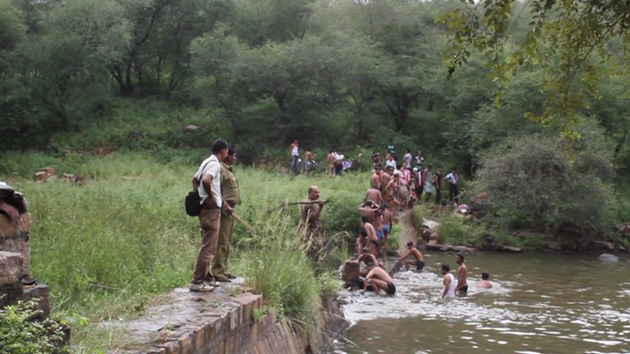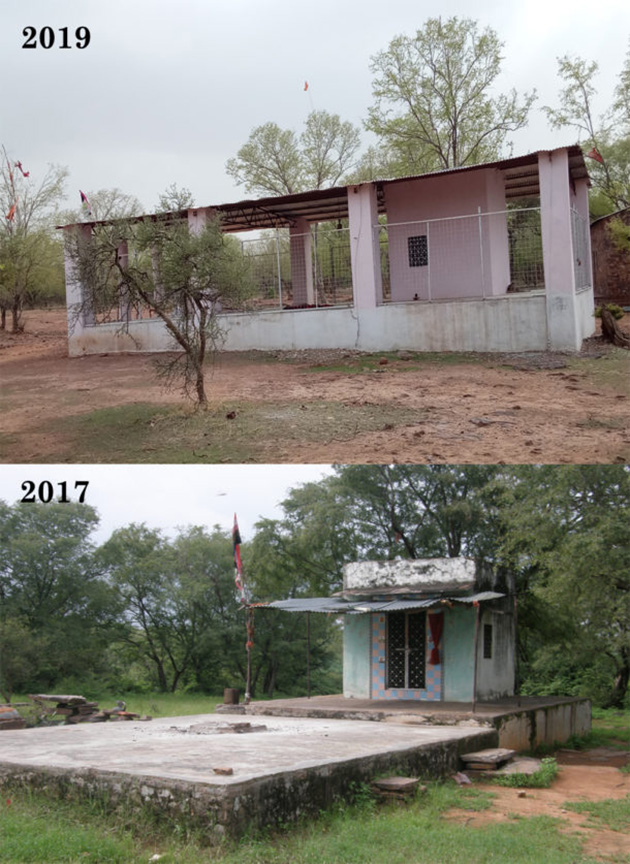[Commentary] Tigers, tourists and pilgrims: The ecological impact of pilgrimage sites in protected areas

- There is strict control on tourists visiting national parks or tiger reserves but pilgrimage inside a protected area is one easy way to enter such areas.
- Over the years, pilgrimage tourism inside protected areas has increased substantially resulting in a large human footprint in such areas, argue Meenu Dhakad and Ishan Dhar in this commentary.
- The authors advocate a series of measures like regulation of infrastructure development at such sites and control pollution to protect wildlife and the original character of such protected areas.
When one visits a national park or tiger reserve in India, be it as a safari tourist or as a scientific researcher, one pays entrance fees and applies for permissions. It is a strictly monitored process, where identities are established through some sort of identity cards before limited entry is granted for a short duration of time. Many scientists can also attest to the long but thorough bureaucratic process involved before being granted permission to carry out research within a protected area. However, there is a way to visit just such a forested area with no questions asked. Not only can one enter unchecked, but one can also traverse on foot, bathe in water bodies, play music, cook food, feed animals and even camp inside the forest overnight! Just how is this possible? One might ask. All of the above is possible if one enters a protected area on pilgrimage.
While there has been considerable debate on the impact of safari tourism in protected areas, there has been no major discussion on the impact of pilgrims in the same areas. Pilgrimages are not just happening in obscure forests, they occur in very prominent and highly protected areas, such as Ranthambhore Tiger Reserve (RTR), Sariska Tiger Reserve, Periyar Tiger Reserve and Gir National Park. Thousands of sites of worship and pilgrimage from different religions are found in forests across India, but there are two new disturbing trends.
The first is that a large proportion of visits to pilgrimage sites in protected areas today is not motivated by religious belief but by recreational tourism. In the past, remoteness and the hardships incurred whilst treading difficult forest paths made religious sites in forests hard to access. Religious sites were small and visited by a few pilgrims, leaving a very small ecological footprint. Now, the number of pilgrims has steadily grown due to economic development and consequent access to better modes of transport. While many defend the rights of local people to make such visits, traditional pilgrimages have given way to a form of tourism, complete with new ‘festivals’ that have no basis in religion nor cultural practice, such as ‘January 1st’.
There has been some discourse on the management of more prominent pilgrimage sites in protected areas such as the Trinetra Ganesh in Ranthambore, with no result. This discourse overshadows recent developments in the numerous smaller pilgrimage sites dotted throughout protected areas, bringing us to our second trend. These sites have not only seen an exponential influx of pilgrims but as a result, have also seen a considerable expansion in size and infrastructure, leaving several ecological problems in their wake which have gone unnoticed.

Insights from a case study
A case study by a Ranthambhore-based non-governmental organisation, Tiger Watch, measured these trends and found that numbers of pilgrims into the RTR have been steadily increasing. There are several large and small religious sites inside the RTR which was declared a tiger reserve in 1973. Before that, there were many villages within its boundaries, which were relocated in the coming years. While the villages themselves were relocated, the religious sites in the villages were left behind inside the tiger reserve. This resulted in people coming back inside the protected area on pilgrimage. In the past, the number of pilgrims was low, but with time and an increase in the availability of transport, the numbers have been steadily increasing.
The study identified a total of 352 religious sites within 615.49 square kilometres (out of a total of 1700 km2) of critical tiger habitat. All of these sites were visited by 2.2 million pilgrims annually, out of which 1.2 million goes to the famous Trinetra Ganesh temple, but the remaining one million pilgrims were going to numerous smaller sites inside the tiger reserve.
It was estimated that annually 175,854 vehicles were going inside the RTR for pilgrimage. 110,300 vehicles went to the Trinetra Ganesh temple while 65,554 vehicles accounted for the remaining sites. However, the vast majority of sites (208) were inaccessible by vehicle, causing pilgrims to traverse critical tiger habitat on foot. Pilgrimage sites have also seen a whopping growth in infrastructure recently: 16 sites were under construction, 18 sites have electricity, 10 sites have solar lighting, eight sites have borewells, 50 sites have handpumps, 36 sites are located near natural water bodies, at 83 sites loudspeakers are operational and at 186 sites pilgrims cook food for ritualistic offerings. The presence of non-biodegradable waste was found near all of the pilgrimage sites.

An expanding ecological footprint
Religious sites are usually found in prime habitat areas for wildlife. This is because they are normally located in the vicinity of natural water bodies like waterholes, waterfalls or springs. The locations of these sites mean that pilgrim activity has a direct impact on wildlife especially when these areas are rapidly modified. This primarily disturbs wildlife because they fulfil the drinking water requirements of wildlife, but pilgrims also use them to bathe and immerse items of worship like flowers. All such activity makes these water bodies unsuitable for wild animals for significant periods of time.
When a large number of pilgrims visit any religious site, there are also possibilities of human-wildlife conflict. Traversing forested paths on foot has led to attacks on pilgrims by carnivores like tigers. In addition, the behaviour of wild species near religious sites has also been altered, they treat ritualistic food offerings as a food source and some wild specimens living in the vicinity of such sites are visibly unhealthy upon observation. This is a slow and more obscure manifestation of human-wildlife conflict.
Moreover, the disposal of plastic waste along with food material and defecation on forest tracks leads to water pollution, soil infection as well as making the air malodorous. However, with the increase in pilgrims and the changing nature of pilgrimage, an ever-increasing variety of waste is being generated in the forested areas near religious sites.
Some of the religious sites play music on loudspeakers and musical instruments. This noise pollution is dramatically increased during festivals due to the presence of large numbers of pilgrims. This disturbs wildlife and forces them to abandon all proximate areas.
The pilgrims usually depend on the forest for their needs, which adversely affects the forest and its wildlife. When pilgrims visit religious sites they camp in nearby areas and cook food for themselves and for their worship, which ultimately leads to the destruction of vegetation and increases the risk of forest fires.
There is amenity growth in these sites as well like the provision of electricity and running water. Therefore these sites have a greater chance of expanding and developing new infrastructure in the future and this increases the probability of an even larger increase in pilgrim numbers. Thus it is not only the coming and going of pilgrims that is a problem, but their ability to stay within a protected area for protracted periods of time which only compounds their negative ecological impact.

How can this be regulated?
Disturbance of this magnitude in protected areas warrants serious attention. Traditional pilgrims are not necessarily at odds with wildlife or nature and while pilgrimage cannot be stopped altogether, the pilgrims can still be managed to ensure that they only leave a small ecological footprint, as they did in the past. Local policymakers have previously suggested untenable solutions that can only increase footfall to pilgrimage sites and not restrict it, such as ropeways and walled walkways to select sites.

Many religious sites organise festival fairs on the basis of the lunar calendar, therefore the exact dates of festivals are unanticipated by forest authorities who are not cognizant of it. A lunar calendar highlighting festival dates needs to be prepared annually so that forest authorities can anticipate pilgrim influxes in various sites within a protected area and prepare accordingly. The shapes and sizes of all religious sites in a protected area need to be regularly monitored through satellite imaging to ensure that they are not expanding in size.
Pilgrimages to parts of the forest that are inaccessible should be planned in consultation with forest authorities so that those particular pathways can be monitored. Modes of transport to pilgrimage sites need to be restricted in order to control both pilgrim numbers and pollution. All infrastructural development on religious sites needs to be strictly regulated, not only to prevent an increase in size but to halt the erection of facilities that will allow visitors to stay overnight in protected areas.
CITATION:
Meenu, D., Dharmendra, K., Paranjpe, D. A., Ishan, D., Mukesh, S., & Sahu, Y. K. (2020). Challenges presented by pilgrimage sites and their impact on ecology of protected areas: a case study of Ranthambhore Tiger Reserve, Rajasthan. Indian Forester, 146(5), 429-439.
This article first appeared on Mongabay.







